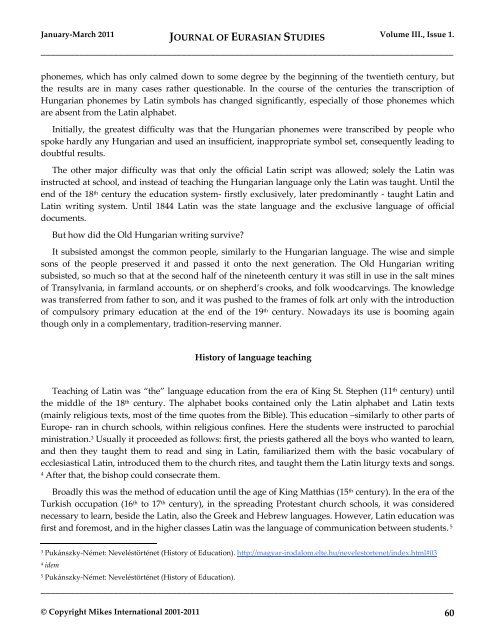JOURNAL OF EURASIAN STUDIES
JOURNAL OF EURASIAN STUDIES
JOURNAL OF EURASIAN STUDIES
You also want an ePaper? Increase the reach of your titles
YUMPU automatically turns print PDFs into web optimized ePapers that Google loves.
January-March 2011 <strong>JOURNAL</strong> <strong>OF</strong> <strong>EURASIAN</strong> <strong>STUDIES</strong> Volume III., Issue 1.<br />
_____________________________________________________________________________________<br />
phonemes, which has only calmed down to some degree by the beginning of the twentieth century, but<br />
the results are in many cases rather questionable. In the course of the centuries the transcription of<br />
Hungarian phonemes by Latin symbols has changed significantly, especially of those phonemes which<br />
are absent from the Latin alphabet.<br />
Initially, the greatest difficulty was that the Hungarian phonemes were transcribed by people who<br />
spoke hardly any Hungarian and used an insufficient, inappropriate symbol set, consequently leading to<br />
doubtful results.<br />
The other major difficulty was that only the official Latin script was allowed; solely the Latin was<br />
instructed at school, and instead of teaching the Hungarian language only the Latin was taught. Until the<br />
end of the 18 th century the education system- firstly exclusively, later predominantly - taught Latin and<br />
Latin writing system. Until 1844 Latin was the state language and the exclusive language of official<br />
documents.<br />
But how did the Old Hungarian writing survive?<br />
It subsisted amongst the common people, similarly to the Hungarian language. The wise and simple<br />
sons of the people preserved it and passed it onto the next generation. The Old Hungarian writing<br />
subsisted, so much so that at the second half of the nineteenth century it was still in use in the salt mines<br />
of Transylvania, in farmland accounts, or on shepherd’s crooks, and folk woodcarvings. The knowledge<br />
was transferred from father to son, and it was pushed to the frames of folk art only with the introduction<br />
of compulsory primary education at the end of the 19 th century. Nowadays its use is booming again<br />
though only in a complementary, tradition-reserving manner.<br />
History of language teaching<br />
Teaching of Latin was “the” language education from the era of King St. Stephen (11 th century) until<br />
the middle of the 18 th century. The alphabet books contained only the Latin alphabet and Latin texts<br />
(mainly religious texts, most of the time quotes from the Bible). This education –similarly to other parts of<br />
Europe- ran in church schools, within religious confines. Here the students were instructed to parochial<br />
ministration. 3 Usually it proceeded as follows: first, the priests gathered all the boys who wanted to learn,<br />
and then they taught them to read and sing in Latin, familiarized them with the basic vocabulary of<br />
ecclesiastical Latin, introduced them to the church rites, and taught them the Latin liturgy texts and songs.<br />
4 After that, the bishop could consecrate them.<br />
Broadly this was the method of education until the age of King Matthias (15 th century). In the era of the<br />
Turkish occupation (16 th to 17 th century), in the spreading Protestant church schools, it was considered<br />
necessary to learn, beside the Latin, also the Greek and Hebrew languages. However, Latin education was<br />
first and foremost, and in the higher classes Latin was the language of communication between students. 5<br />
3 Pukánszky-Német: Neveléstörténet (History of Education). http://magyar-irodalom.elte.hu/nevelestortenet/index.html#03<br />
4 idem<br />
5 Pukánszky-Német: Neveléstörténet (History of Education).<br />
_____________________________________________________________________________________<br />
© Copyright Mikes International 2001-2011 60

















